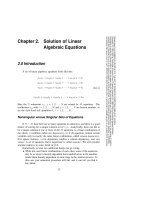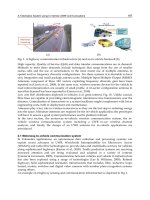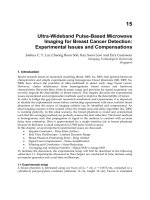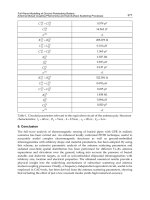BIOMES OF THE EARTH - GRASSLANDS Part 1 doc
Bạn đang xem bản rút gọn của tài liệu. Xem và tải ngay bản đầy đủ của tài liệu tại đây (6.03 MB, 29 trang )
Michael Allaby
Illustrations by
Richard Garratt
BIOMES OF THE EARTH
GRASSLANDS
Grasslands
Copyright © 2006 by Michael Allaby
All rights reserved. No part of this book may be reproduced or utilized in any form or by any
means, electronic or mechanical, including photocopying, recording, or by any information
storage or retrieval systems, without permission in writing from the publisher. For information
contact:
Chelsea House
An imprint of Infobase Publishing
132 West 31st Street
New York NY 10001
ISBN-13: 978-0-8160-5323-0
ISBN-10: 0-8160-5323-5
Library of Congress Cataloging-in-Publication Data
Allaby, Michael.
Grasslands / author
, Michael Allaby ; illustrations by Richard Garratt.
p. cm.—(Biomes of the Earth)
Includes bibliographical references and index.
ISBN 0-8160-5323-5
1. Grassland ecology—Juvenile literature. 2. Grasslands—Juvenile literature. I. Garratt,
Richard, ill. II. Title. III. Series.
QH541.5.P7A38 2006
577.4—dc22 2005005615
Chelsea House books are available at special discounts when purchased in bulk quantities for
businesses, associations, institutions, or sales promotions. Please call our Special Sales
Department in New York at (212) 967-8800 or (800) 322-8755.
You can find Chelsea House on the World Wide Web at
Text design by David Strelecky
Cover design by Cathy Rincon
Illustrations by Richard Garratt
Photo research by Elizabeth H. Oakes
Printed in Hong Kong
CP FOF 10 9 8 7 6 5 4 3 2
This book is printed on acid-free paper.
From Richard Garratt:
To Chantal, who has lightened my darkness.
Acknowledgments xiii
Introduction: What are grasslands? xv
CHAPTER 1
GEOGRAPHY OF GRASSLANDS 1
Where grasslands occur 1
T
emperate grasslands and tropical grasslands 3
Prairie 4
Steppe 7
Pampa 10
Veld 12
Tropical grasslands of South America 14
Savanna 17
Australian grasslands 20
Upland grasslands 22
CHAPTER 2
GEOLOGY OF GRASSLANDS 26
Movement of continents 26
Alfred Lothar Wegener and continental drift 28
How mountains rise and wear away 31
Grassland soils 37
How soils are classified 39
Laterite 40
Water and grasslands 41
CHAPTER 3
GRASSLAND CLIMATES 45
Why there are seasons 45
Continental and maritime climates
48
How climates are classified 49
CONTENTS
Dry seasons and rainy seasons 51
The Dust Bowl 55
Monsoons 57
Adiabatic cooling and warming 59
El Niño 61
Convection and storms 64
Lapse rates and stability 66
Tornadoes 67
CHAPTER 4
HISTORY OF GRASSLANDS 71
Evolution of grasslands 71
Grasslands and past climate changes
73
How forest can change into grassland 76
The transformation of New Zealand 78
CHAPTER 5
LIFE ON THE GRASSLANDS 81
What is grass? 81
How grasses work
84
Photosynthesis 85
Prairie grasses 89
Pampas grasses 92
Steppe grasses 94
Savanna grasses 95
Grassland trees and shrubs 99
Grassland herbs 100
Grassland insects 103
Mongooses, prairie dogs, marmots, ground
squirrels, and pocket gophers 110
Snakes and lizards 114
Grazing animals 119
Hunters of the grasslands 124
Hunter and prey: The evolutionary arms race 130
Grassland birds 130
Coping with drought 136
Coping with heat and cold 139
Hibernation 141
CHAPTER 6
GRASSLAND ECOLOGY 143
How the plant eaters help the grass 143
Food chains and food webs
144
Ecological pyramids 147
Do predators control their prey? 151
How herding provides safety in numbers 153
Mammal migrations 155
CHAPTER 7
PEOPLES OF THE GRASSLANDS 158
Peoples of the prairie 158
Homesteaders and the way the prairie was
transformed
160
Indians and gauchos: The peoples of the pampa 165
Farmers of the pampa 167
Peoples of the African savanna 169
Traditional life on the steppe of Central Asia 171
Genghis Khan, the Golden Horde, and
Mogul emperors 173
Aboriginal peoples of the Australian grasslands 177
CHAPTER 8
USES FOR GRASSLAND 179
Cereal farming 179
The origin of cereals 180
Cattle ranching 182
The origin of cattle 184
Sheep farms of Australia and New Zealand 186
The origin of sheep 189
Upland sheep farming 190
Forestry 191
Biofuel production 194
Biofuels and the greenhouse effect 195
CHAPTER
9
BIODIVERSITY AND GRASSLANDS 198
What is biodiversity? 198
Why it matters 199
Protecting grassland species 201
The Biodiversity Convention 202
CHAPTER
10
THREATS TO GRASSLAND 205
Conversion to farmland 205
Conversion to forest
207
Overgrazing and soil erosion 209
Climate change 211
The greenhouse effect 212
Expansion of towns and roads 214
CHAPTER 11
MANAGING THE GRASSLANDS 218
Lessons from the Dust Bowl 218
Ranching on equatorial grasslands
220
Farming tropical grasslands 222
Dry farming 224
Grassland restoration and conservation 225
CONCLUSION 228
What future for the grasslands? 228
SI units and conversions
231
Soil classification: Orders of the soil taxonomy 235
Glossary 239
Bibliography and further reading 253
Index 257
IX
Earth is a remarkable planet. There is nowhere else in our
solar system where life can survive in such a great diversity of
forms. As far as we can currently tell, our planet is unique.
Isolated in the barren emptiness of space, here on Earth we
are surrounded by a remarkable range of living things, from
the bacteria that inhabit the soil to the great whales that
migrate through the oceans, from the giant redwood trees of
the Pacific forests to the mosses that grow on urban side-
walks. In a desolate universe, Earth teems with life in a bewil-
dering variety of forms.
One of the most exciting things about the Earth is the rich
pattern of plant and animal communities that exists over its
surface. The hot, wet conditions of the equatorial regions
support dense rain forests with tall canopies occupied by a
wealth of animals, some of which may never touch the
ground. The cold, bleak conditions of the polar regions, on
the other hand, sustain a much lower variety of species of
plants and animals, but those that do survive under such
harsh conditions have remarkable adaptations to their test-
ing environment. Between these two extremes lie many
other types of complex communities, each well suited to the
particular conditions of climate prevailing in its region.
Scientists call these communities biomes.
The different biomes of the world have much in common
with one another
. Each has a plant component, which is
responsible for trapping the energy of the Sun and making it
available to the other members of the community. Each has
grazing animals, both large and small, that take advantage of
the store of energy found within the bodies of plants. Then
come the predators, ranging from tiny spiders that feed upon
even smaller insects to tigers, eagles, and polar bears that sur-
vive by preying upon large animals. All of these living things
PREFACE
form a complicated network of feeding interactions, and, at
the base of the system, microbes in the soil are ready to con-
sume the energy-rich plant litter or dead animal flesh that
remains. The biome, then, is an integrated unit within which
each species plays its particular role.
This set of books aims to outline the main features of each
of the Earth’s major biomes. The biomes covered include the
tundra habitats of polar regions and high mountains, the
taiga (boreal forest) and temperate forests of somewhat
warmer lands, the grasslands of the prairies and the tropical
savanna, the deserts of the world’s most arid locations, and
the tropical forests of the equatorial regions. The wetlands of
the world, together with river and lake habitats, do not lie
neatly in climatic zones over the surface of the Earth but are
scattered over the land. And the oceans are an exception to
every rule. Massive in their extent, they form an intercon-
necting body of water extending down into unexplored
depths, gently moved by global currents.
Humans have had an immense impact on the environ-
ment of the Earth over the past 10,000 years since the last Ice
Age. There is no biome that remains unaffected by the pres-
ence of the human species. Indeed, we have created our own
biome in the form of agricultural and urban lands, where
people dwell in greatest densities. The farms and cities of the
Earth have their own distinctive climates and natural history,
so they can be regarded as a kind of artificial biome that peo-
ple have created, and they are considered as a separate biome
in this set.
Each biome is the subject of a separate volume. Each richly
illustrated book describes the global distribution, the climate,
the rocks and soils, the plants and animals, the history, and
the environmental problems found within each biome.
Together, the set provides students with a sound basis for
understanding the wealth of the Earth’s biodiversity, the fac-
tors that influence it, and the future dangers that face the
planet and our species.
Is there any practical value in studying the biomes of the
Earth? Perhaps the most compelling reason to understand
the way in which biomes function is to enable us to conserve
their rich biological resources. The world’s productivity is the
X GRASSLANDS
basis of the human food supply. The world’s biodiversity
holds a wealth of unknown treasures, sources of drugs and
medicines that will help to improve the quality of life. Above
all, the world’s biomes are a constant source of wonder,
excitement, recreation, and inspiration that feed not only
our bodies but also our minds and spirits. These books aim to
provide the information about biomes that readers need in
order to understand their function, draw upon their
resources, and, most of all, enjoy their diversity.
PREFACE XI
Richard Garratt drew all of the diagrams and maps that
appear in this book. Richard and I have been working togeth-
er for many years in a collaboration that succeeds because
Richard has a genius for translating the weird electronic
squiggles I send him into clear, simple artwork of the highest
quality. As always, I am grateful to him for all his hard work.
I also wish to thank Elizabeth Oakes for her fine work as a
photo researcher.
I must thank Frank K. Darmstadt, Executive Editor, at
Chelsea House. Frank shaped this series of books and guided
them through all the stages of their development. His
encouragement, patience, and good humor have been
immensely valuable.
I am especially grateful to Dorothy Cummings, project edi-
tor. Her close attention to detail sharpened explanations that
had been vague, corrected my mistakes and inconsistencies,
and identified places where I repeated myself. And occasion-
ally Dorothy was able to perform the most important service
of all: She intervened in time to stop me making a fool of
myself. No author could ask for more. This is a much better
book than it would have been without her hard work and
dedication.
Michael Allaby
Tighnabruaich
Argyll
Scotland
www.michaelallaby.com
ACKNOWLEDGMENTS
What are grasslands?
A wave moves over the landscape as the rustling grass bows
before the wind and then rises again. Another wave follows
the first, and then another, and the eye follows the rippling
motion across the plain until each wave disappears in the
haze that obscures the distant horizon. Overhead the cloud-
less sky is the palest blue, and immensely large. On a moon-
less night the sky blazes with the light from countless mil-
lions of stars.
Grass is the predominant vegetation, but it is mixed with a
bewildering variety of other herbs. Scattered shrubs and
small belts of trees lining the river courses relieve what might
otherwise be a monotonous scene. Birds fly overhead, forag-
ing for insects or seeds, and high above them the hawks circle
slowly, alert to the tiniest flicker of movement that betrays
the presence of a small animal. Mice and ground squirrels
live on and below the ground, feeding on the vegetation and
ever watchful for snakes as well as birds of prey. Herds of big-
ger animals graze the pasture and browse the leaves of shrubs
and the lower branches of the trees.
This is one of the world’s great grasslands, which lie
between the temperate forests and the semiarid lands border-
ing the desert, where meager seasonal rains allow a sparse,
coarse pasture to survive. Grasslands once covered more than
1 million square miles (2.59 million km
2
) in North America,
extending from Illinois to Colorado and from Alberta to
Texas.
It is a place of changing colors. In winter the northern
grasslands are white, hidden beneath a covering of snow.
Southern grasslands see little or no snow, and there the
land remains brown through the winter. In spring both are
green, as the returning warmth and moisture from the rain
INTRODUCTION
XVI GRASSLANDS
or melting snow stimulate new plant growth. As the hot, dry
summer progresses, the plants wilt and then turn yellow and
brown.
Grasslands occur in the deep interior of continents, far
from the ocean, where rainfall is generally low. Temperate
grasslands receive an average 12–40 inches (305–1,016 mm)
of rain a year and tropical grasslands 25–60 inches
(635–1,524 mm). Rainfall is not distributed evenly through
the year, however. In temperate regions there is a dry season
that begins in the late summer, fall, or winter and continues
until spring. In the Tropics the dry season begins in early
summer and most of the rain falls in the winter.
Although grasses are the most abundant plants in all grass-
land, there are many types of grasses, and grasslands are not
all the same. Tropical grasslands lie between the edge of the
subtropical deserts and the tropical forests. They are often
called savanna (or savannah) grasslands, a name that seems to
have originated in the Caribbean region and to have entered
English from zavana, which was the Spanish form of the orig-
inal name. Savanna grasslands extend across Africa as two
belts, one on each side of the equator
. Grasslands of this type
also occur in South America, southern Asia, and Australia.
They are usually dominated by grasses five to six feet (1.5–1.8
m) tall, interspersed with thorn trees that are mostly less
than 33 feet (10 m) tall and have distinctive flat tops.
Savanna grasslands have regional names. They are called
llanos in Venezuela and Colombia, and campo cerrado and
campo sujo are two different varieties of savanna found in
Brazil. The Australian grasslands are identified not by their
grasses, but by the species of acacia trees that grow among
the grasses: brigalow scrub and mulga scrub.
Temperate grasslands occur between the subtropical de-
serts and the temperate forests or the coniferous forest
known as taiga. Where rainfall is relatively high, the grasses
are about five feet (1.5 m) tall. These are the typical grasses
of North American prairie and they occur on the eastern side
of the continent. Shorter grasses—less than 18 inches (45
cm) tall—grow on the drier western side, in the plains,
although nowadays the two types of grassland are usually
called tallgrass and short-grass prairie. Palouse prairie, also
called bunchgrass prairie, grows in Washington State and
British Columbia.
In South America the temperate grassland is called pampa.
The Eurasian grasslands stretch from Hungary in the west,
across Russia, and as far as Mongolia and China. They are
called puszta in Hungary and steppe in Russia. There are two
main types of steppe. Meadow steppe occurs in the north,
where the climate is relatively moist, allowing many flower-
ing herbs to flourish. Dry steppe occurs in the south and sup-
ports fewer herbs. Southern African grasslands are called veld
or grassveld.
Climate determines the growing season for plants any-
where in the world, and grasslands are no exception. In tem-
perate regions plants are able to grow when the temperature
is above freezing. The growing season in the prairie lasts from
about 150 days in the palouse prairie to 270 days in T
exas. In
the Tropics, where the temperature is warm enough for plant
growth throughout the year, rainfall is the crucial factor.
A type of vegetation that covers a very large area in conti-
nents around the world is called a biome, and geographers
divide the entire world into a series of biomes. The species of
plants vary from one part of a biome to another; what mat-
ters is that the predominant plants are all similar
. They might
be temperate trees, for example, or tropical trees, or grasses,
but regardless of the species, North American grassland is
much more similar to South American, Eurasian, African, or
Australian grassland than any of these is to forest.
All biomes are important to us, but the grassland biome is
especially important. Most of our staple foods, including
wheat, rice, barley, rye, corn (maize), and sugarcane, are
grasses, and wheat, barley, and rye were first cultivated on
the grasslands of what are now Turkey and Iraq. Our cereal
and livestock farms are like artificial grassland and in many
places the lands they occupy were natural grasslands until
farmers cleared away the wild grasses to grow cultivated
grasses.
Some areas of natural grassland are not suitable for farm-
ing, usually because they experience severe and prolonged
drought from time to time, but many make good farmland.
This means they are valuable, and over the centuries most of
INTRODUCTION XVII
the natural grassland has been converted into farmland.
When the grassland is plowed, the plants that grow among
the grasses are destroyed along with the grasses themselves,
and many of the animals that find food and shelter among
the plants die or move away. If we wish the members of the
natural grassland community to survive, we must preserve
areas of the grassland itself.
XVIII GRASSLANDS
Where grasslands occur
Grasslands once covered more than 40 percent of the Earth’s
land surface. Grasses are geographically more widespread
than any other group of plants, and grasslands compose one
of the most extensive types of vegetation on the planet. As
the map shows, they are found on every continent except
Antarctica.
Although the map shows the areas where grassland is the
natural vegetation, in fact large areas of grassland have been
converted to farmland. Where the rainfall is sufficient to sup-
port farming, the abundant sunshine, level plains, and fertile
soils are ideal for growing wheat and corn. These crops are
also grasses, so the conversion is from one type of grassland
to another. Agricultural grassland may also consist of pasture
grasses that have been sown to feed livestock.
Grasses thrive in climates that are too dr
y for most trees.
They tolerate grazing by animals (see “How grasses work” on
pages 85–90), but they cannot survive in deep shade.
Consequently natural grasslands occupy those parts of the
world that are neither desert, which is too dry, nor forest,
which is too shady.
The map divides grasslands into two types—temperate
grassland and tropical savanna grassland. Temperate grass-
land occurs in regions with a temperate climate and is most
widespread in North America, eastern Europe, Turkey and
northern Iran, central Asia, and part of southern China.
There is much less land in the Southern Hemisphere to the
south of the tropic of Capricorn, and that is why southern
temperate grasslands are confined to part of Argentina and a
small area of Peru and South Africa.
Savanna grassland covers a large part of Africa, extending
from the southern edge of the Sahara to the southeastern tip
GEOGRAPHY
OF GRASSLANDS
CHAPTER 1
1
of the continent, broken only by areas of tropical forest. There
are also large areas of savanna in South America and Australia.
The climatic conditions that favor grasslands also occur in
mountainous regions. Temperature decreases with altitude,
and there is a level beyond which the mountain climate is
too cold for trees. At this height—and it varies according to
the latitude (see “Upland grasslands” on pages 22–25)—the
growing season is so short that the needles of coniferous trees
have insufficient time to mature before they are killed by
frost. Trees cannot survive, but grasses and many flowering
herbs are able to do so. Between the upper limit for tree
growth, called the tree line, and the region of bare rock and
permanent snow
, there are mountain grasslands, more often
known as alpine meadows. Their composition varies from
place to place, and in the Tropics there are also alpine savan-
nas. Alpine grasslands occur in mountain ranges throughout
the world.
2 GRASSLANDS
tropic of Cancer
tropic of Capricorn
equator
Distribution of temperate
and tropical grasslands.
Grasslands tend to
occupy the interior of
continents, where
the rainfall is sparse
because of the distance
from the ocean.
GEOGRAPHY OF GRASSLANDS 3
Grasses are quick to invade land that has been cleared of
other types of vegetation. Ordinarily these grasses will disap-
pear if taller plants, such as shrubs and trees, become estab-
lished and shade the ground. There are places, however,
where this has not been allowed to occur, resulting in succes-
sional grasslands that are maintained by burning or grazing,
both of which destroy shrub and tree seedlings. Successional
savanna grassland has replaced tropical forest in many areas.
Farmers clear an area of forest, farm it for a few years, and
then abandon it to allow the soil to recover fertility
. If they
return to the site before the forest has had time to reclaim it,
over a number of these cycles grasses may replace the trees.
Such farming has not only extended the boundary of the
savanna grassland into what was formerly forest; it has also
produced areas of grassland inside the forest.
Temperate grasslands and tropical grasslands
Temperate and tropical grasslands are distinguished by their
climate. They occur inland and are confined to particular lat-
itudes, because climate characteristics largely depend on dis-
tance from the equator and from the ocean (see the sidebar
“How climates are classified” on page 49).
Different climates suit different types of plant. Although
grass is the most obvious and abundant vegetation in any
grassland, there are many species of grass and those found in
one type of grassland could not survive in another. All grass-
es share certain characteristics (see “What is grass?” on pages
82–84) that make them resemble each other more closely
than they resemble any other type of plant, such as a tree.
But the great variety among grasses gives each kind of grass-
land a distinctive appearance, and there is a great contrast
between temperate and tropical grasslands.
Temperate grasslands consist of grasses and herbs that
extend across vast plains with occasional low, rolling hills.
Trees grow only beside rivers—and rivers are often many
miles apart. Although there are also areas of tropical grass-
land that contain only grasses and herbs, woody plants—
shrubs and trees—grow in most savanna grasslands. The
number of woody plants varies from place to place, but
because of them much of the savanna is open woodland or
parkland, in which scattered shrubs and trees are surrounded
by grass. Depending on the number of woody plants, tropical
grasslands are divided into three categories: savanna wood-
land, savanna parkland, and savanna grassland. In savanna
woodland the tree canopy covers more than 50 per
cent of
the ground; in savanna parkland it covers between 20 per-
cent and 50 percent; and in savanna grassland it covers less
than 20 percent.
The weather is always warm everywhere in the savanna.
The average temperature is higher than 64°F (18°C) through-
out the year, although occasionally it can fall as low as 40°F
(4°C). It rises to 80°–100°F (27°–38°C) in summer. The three
to five months of winter are not cold; they are dry (see “Dry
seasons and rainy seasons” on pages 51–55). During the rainy
season the amount of rainfall ranges from about two inches
(50 mm) near the desert edge to 60 inches (1,525 mm) close
to the edge of the tropical rain forest. Where rainfall is heavy,
it often causes flooding. Savanna woodland occurs in the
wetter areas and savanna grassland prevails where the rainfall
is low.
Temperate grassland also grows in a fairly dry climate
where prolonged drought occurs from time to time.
Droughts occasionally last for 10 years (see “The Dust Bowl”
on pages 55–57). Annual rainfall on the North American
grasslands averages about 40 inches (1,016 mm) in the east,
decreasing to about 10 inches (250 mm) in the west, and it
occurs mainly in winter. As well as being dry, summers are
hot, with temperatures rising to 100°F (38°C). Winters are
cold, with daytime temperatures falling to about 10°F (–12°C)
or sometimes much lower. The lowest temperature ever
recorded in Winnipeg, Manitoba, was –54°F (–48°C), and
Saskatoon, Saskatchewan, has recorded –55°F (–48°C). High
summer temperatures and the incessant wind mean that the
rate of evaporation is high, making the soil very dry.
Prairie
The first Europeans to gaze upon the grasslands of North
America were French. They approached from the east and
4 GRASSLANDS
GEOGRAPHY OF GRASSLANDS 5
saw before them an ocean of waving grass extending across
the level plain as far as the horizon. As they moved through
it and the horizon receded, the grassland continued to
stretch for as far as they could see. It seemed endless. The
French called it la prairie, “the meadow.”
Nowadays people often call the whole of the North
American grassland “prairie,” but as the map shows, there are
several distinct types of grassland. Originally only the tall-
grass grassland was called prairie. The short-grass grassland
was known simply as “the plains,” and the area of overlap
Gulf of Mexico
tallgrass prairie
mixed-grass prairie
short-grass prairie
bunchgrass prairie
Hudson Bay
PACIFIC OCEAN
Prairie. There are
several types of prairie.
Tallgrass prairie occurs
in the east, where the
climate is moister than
it is farther west, where
short-grass prairie is
found. Mixed-grass
prairie forms a wide
boundary between the
two and contains both
tall and short grasses.
Bunchgrass and desert
grassland are found to
the west and south of
the short-grass prairie.
between the two was called “mixed prairie.” Bunchgrass
prairie, or palouse prairie, occurs to the west of the Rocky
Mountains from Colorado to Oregon and northward to
British Columbia, and in part of California. T
allgrass and
short-grass areas are defined by the height of the grasses
when they are in flower. All of the plants die down in winter,
and although most of them are perennial—living for many
years—growth above ground starts afresh each year
.
Big bluestem (Andropogon gerardii) is the most typical grass
of the tallgrass prairie. It flowers in late summer
, when it
reaches an average height of five feet (1.5 m). In some places
big bluestem can reach a height of 10 feet (3 m). Other tall-
grass species include sand bluestem (A. halli), Indian grass
(Sorghastrum nutans), slough grass (Spartina pectinata), and
switchgrass (Panicum virgatum). All of these grow 3.3–10 feet
(1–3 m) tall. Growing among the grasses there is a wide range
of herbs, called forbs.
Tallgrass prairie grows in the east, where the annual rain-
fall averages about 34 inches (864 mm), with rather more
falling in summer than in winter
. Formerly, in spring, after
the thin covering of snow had melted but before the temper-
ature had risen high enough to evaporate water near the sur-
face, the native prairie was very wet in some places.
Nowadays the ground is much drier. The land has been
drained and plowed, and today it grows wheat and corn.
Most of the tallgrass prairie has disappeared.
Short-grass prairie—the plains grassland—grows to the
west of longitude 100°W, where the climate is drier. Great
Falls, Montana, for example, has an average annual rainfall
of 15.3 inches (388 mm). Farmers can grow row crops only
where they are able to irrigate their fields, and the area is
mainly given over to cattle ranching. The low rainfall also
means that native plants cannot grow very tall. Most of the
grassland plants are less than eight inches (20 cm) high.
These include buffalo grass (Buchloe dactyloides), galleta grass
(Hilaria jamesii), needle-and-thread grass (Stipa comata), vari-
ous grama grasses (Bouteloua species), and penn (or
Pennsylvania) sedge (Carex pensylvanica). Grasses survive bet-
ter than most other plants in this climate, so there are fewer
forbs in short-grass prairie than there are in tallgrass prairie.
6 GRASSLANDS









